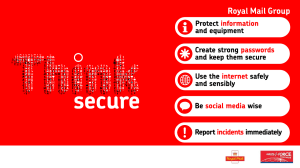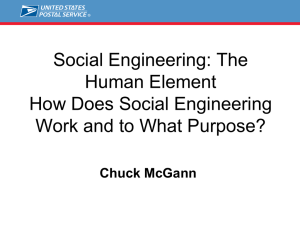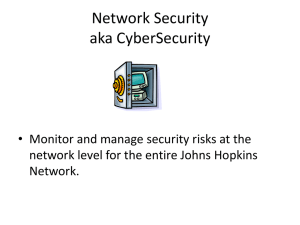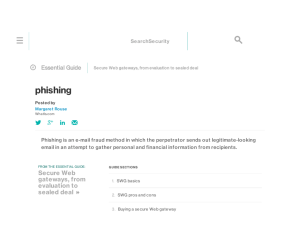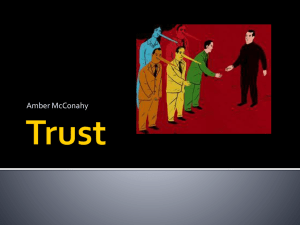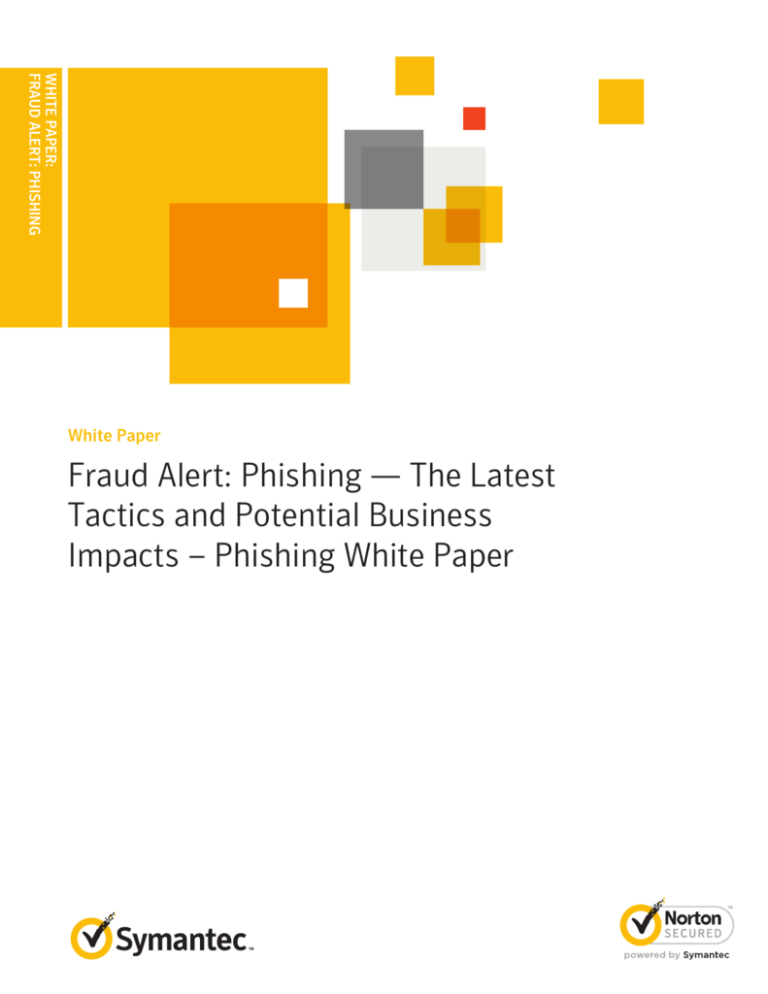
WHITE PAPER:
FRAUD ALERT: PHISHING
White Paper
Fraud Alert: Phishing — The Latest
Tactics and Potential Business
Impacts – Phishing White Paper
White Paper: Fraud Alert - Phishing - The Latest Tactics and Potential Business Impact - Phishing White Paper
Fraud Alert: Phishing — The Latest Tactics and Potential
Business Impact - Phishing White Paper
CONTENTS
Introduction . . . . . . . . . . . . . . . . . . . . . . . . . . . . . . . . . . . . . . . . . . . . . . . . . . . . . . . . . . . . 3
Phishing Knows No Limits . . . . . . . . . . . . . . . . . . . . . . . . . . . . . . . . . . . . . . . . . . . . . . .
Chinese Phishers Increasingly Aggressive . . . . . . . . . . . . . . . . . . . . . . . . . . . . .
Shared Virtual Server Hacking Explodes . . . . . . . . . . . . . . . . . . . . . . . . . . . . . . .
Spammers Continue To Take Advantage Of Holidays And Global Events . . . .
Phishing that Plays on Economic Fears . . . . . . . . . . . . . . . . . . . . . . . . . . . . . . . .
Blended Phishing/Malware Threats . . . . . . . . . . . . . . . . . . . . . . . . . . . . . . . . . . .
Man-in-the-Middle SSL Stripping . . . . . . . . . . . . . . . . . . . . . . . . . . . . . . . . . . . .
Texting and Mobile Phone Phishing Scams . . . . . . . . . . . . . . . . . . . . . . . . . . . . .
How Phishing Could Impact Your Business . . . . . . . . . . . . . . . . . . . . . . . . . . . . .
Protecting Your Business . . . . . . . . . . . . . . . . . . . . . . . . . . . . . . . . . . . . . . . . . . . .
Consumer and Employee Education . . . . . . . . . . . . . . . . . . . . . . . . . . . . . . . . . .
3
4
4
4
5
5
5
5
5
6
7
Phishers: Tough, Shape-Shifting Cyber Adversaries . . . . . . . . . . . . . . . . . . . . . . . . 8
Glossary . . . . . . . . . . . . . . . . . . . . . . . . . . . . . . . . . . . . . . . . . . . . . . . . . . . . . . . . . . . . . . . 8
2
White Paper: Fraud Alert - Phishing - The Latest Tactics and Potential Business Impact - Phishing White Paper
Introduction
As one of the top cyber crime ploys impacting both consumers and businesses,
phishing has remained a consistently potent threat over the past several years. In
fact, the cumulative number of phishing attacks recorded in 2011 represented a 37
percent increase over 2010.1
You no longer need to be a sophisticated hacker to commit fraud on the Internet.
Anyone who is motivated can join in, thanks to the off-the-shelf phishing kits
provided by a thriving cyber crime ecosystem. Cyber criminals are even migrating
to a new business model known as Malware-as-a-Service (MaaS), where authors of
exploit kits offer extra services to customers in addition to the exploit kit itself.2
The impact on a business can be quite severe. RSA estimated in its October 2011
Fraud Report that the worldwide losses from phishing attacks cost more than $520
million in the first half of 2011 alone.3 Whatever the threat – whether employees or
customers have been phished, or the company Web site compromised – phishing
is something to be taken very seriously. Organizations need to stay current on the
latest methods employed by cyber criminals, and proactively take steps to protect
themselves from fraud.
This fraud alert highlights the current growth and trends in today’s phishing
schemes, the potential impact on companies, and insight into how businesses can
apply technology to protect themselves and their customers.
Phishing Knows No Limits
Phishing – the act of luring unsuspecting people to provide sensitive information
such as usernames, passwords, and credit card data via seemingly trustworthy
electronic communications – is a serious threat for both consumers and
businesses. In the decade since phishing arrived on the scene, this fraud method
has been growing rapidly, with one estimate citing approximately 8 million daily
phishing attempts worldwide.4 In 2011, one in every 300 emails transmitted over
the Web was related to phishing.5
The Anti-Phishing Working Group (APWG) reported at least 112,472 unique
phishing attacks globally in the first half of 2011 in 200 top-level domains.6
Although representing a much larger number than the 42,624 attacks that the
APWG observed in the second half of 2010, it was somewhat less than the record
126,697 observed in the second half of 2009, when the Avalanche botnet was on
the loose. Still, 79,753 unique domain names were used in these attacks – the
highest number since 2007 (see Figure 1).
“RSA: October Fraud Report,” RSA, October 2011.
“ Symantec iDefense 2012 Cyber Threats and Trends,” Symantec. 2012.
“RSA: October Fraud Report,” RSA, October 2011.
4
“Counterfeiting & Spear Phishing — Growth Scams of 2009,” Trade Me, Infonews.co.nz, March 2, 2009.
5”
RSA: October Fraud Report,” RSA, October 2011.
6
“Global Phishing Survey 1H2011: Trends and Domain Name Use,” Anti-Phishing Working Group.
1
2
3
3
White Paper: Fraud Alert - Phishing - The Latest Tactics and Potential Business Impact - Phishing White Paper
The increase is attributed to two emerging trends: Chinese phishers have been
registering large numbers of domain names, and hackers instigated a massive
campaign against servers hosting multiple domains.
Basic Statistics
140,000
120,000
100,000
80,000
60,000
40,000
20,000
0
Phishing domain
names
Attacks
1H2009 2H2009 1H2010 2H2010 1H2011
Figure 1: Phishing attacks and phishing domain names continues trending up.*
Chinese Phishers Increasingly Aggressive
Attacks by Chinese phishers were up significantly in the second half of 2010 and
the first half of 2011.7 Indeed, Chinese phishers were responsible for a full 70
percent of all malicious domain name registrations worldwide. In the first half
of 2011, Chinese phishing attacks increased by 44 percent over the second half
of 2010.8
Shared Virtual Server Hacking Explodes
Although hackers are always coming up with new phishing schemes, this one is
actually an old – albeit obscure – one that has been successfully revived. In this
attack, a phisher breaks into a web server that hosts large numbers of domains and
places the phishing site content on every domain, so that every web site on that
server displays the phishing pages. In this manner, phishers can infect thousands
of web sites simultaneously. The APWG identified 42,448 unique attacks that used
this strategy – a number representing 37 percent of all phishing attacks globally.9
Spammers Continue To Take Advantage Of Holidays And Global Events
In the run-up to Christmas in 2011, spammers spoofed a number of legitimate
retailers, offering Christmas “deals” on a range of products. There were a large
number of phishing campaigns relating to the 2011 Japanese earthquake, the
“Arab spring” movement, and other notable global happenings. After the usual
onslaught at Valentine’s Day, anti-phishing experts expect to see a plethora of
emails leading up to Summer Olympics in London.10 Spear phishing attacks,
although less in the news than in previous years, notably increase during holiday
periods when businesses’ security operations tend to be understaffed. That way,
the cyber criminals’ operations have a greater opportunity to succeed. However,
this seems to be less the case between the Christmas and New Year’s holidays. One
possible explanation is that while security teams may be only lightly staffed, there
are also significantly fewer employees working, so fewer opportunities for targeted
users to open malicious attachments.
Ibid.
Ibid.
Ibid.
10
“Symantec Intelligence Report,” Symantec, January 2012.
* Source: APWG.
7
8
9
4
White Paper: Fraud Alert - Phishing - The Latest Tactics and Potential Business Impact - Phishing White Paper
Phishing that Plays on Economic Fears
Today’s economic turmoil delivers unprecedented opportunities for criminals
to exploit victims. For instance, popular scams include phishing e-mails that
look like they are coming from a financial institution that recently acquired the
target victim’s bank, savings & loan, or mortgage holder.11 The large amount of
merger and acquisition activity taking place creates an atmosphere of confusion
for consumers, exacerbated by the dearth of consistent communications with
customers. Phishers thrive in this type of situation.
Blended Phishing/Malware Threats
To increase success rates, some attacks combine phishing with malware for a
blended attack model. For instance, a potential victim receives a phishing e-card
via e-mail that appears to be legitimate. By clicking on the link inside the e-mail
to receive the card, the person is taken to a spoofed Web site which downloads a
Trojan to the victim’s computer. Alternatively, the victim may see a message that
indicates a download of updated software is needed before the victim can view the
card. When the victim downloads the software, it’s actually a keylogger.
Phishing-based keyloggers have tracking components which attempt to monitor
specific actions (and specific organizations such as financial institutions, online
retailers, and e-commerce merchants) in order to obtain sensitive information such
as account numbers, userids, and passwords.
Another type of Trojan that enables phishers to capture sensitive information is a
redirector. Redirectors route end users’ network traffic to a location where it was
not intended to go.
Man-in-the-Middle SSL Stripping
Back in 2008, a new type of malware was introduced that allows cyber criminals to
spoof an encrypted session. This is a variance on the standard man-in-the-middle
(MITM) attack that criminals use to access passwords or sensitive information
passing unprotected over the network.
Texting and Mobile Phone Phishing Scams
Posing as a real financial institution, phishers are using SMS as an alternative to
e-mail to attempt to gain access to confidential account information. Known as
“smishing,” the typical scam informs the mobile phone user that the person’s bank
account has been compromised or credit card/ATM card has been deactivated.
The potential victim is directed to call a number or go to a spoofed Web site to
reactivate the card. Once on the site, or through an automated phone system, the
potential victim is asked for card and account numbers and PIN numbers.
How Phishing Could Impact Your Business
While the financial industry continues to be a primary target for phishers, it’s
certainly not the only sector vulnerable to attack. Auction sites, payment services,
retail, and social networking sites are also frequent targets. The APWG also reports
a massive increase in attacks aimed at cell phone providers and manufacturers. In
short, no business or brand is inherently safe.
“FTC Consumer Alert: Bank Failures, Mergers and Takeovers: A Phish-erman’s Special,” www.ftc.gov
11
5
White Paper: Fraud Alert - Phishing - The Latest Tactics and Potential Business Impact - Phishing White Paper
Phishing attacks that pose as a company’s official Web site diminish the company’s
online brand and deter customers from using the actual Web site out of fear of
becoming a fraud victim. In addition to the direct costs of fraud losses, businesses
whose customers fall victim to a phishing scam also risk:
• A drop in online revenues and/or usage due to decreased customer trust
• Potential non-compliance fines if customer data is compromised
Even phishing scams aimed at other brands can impact a business. The resulting
fear caused by phishing can cause consumers to stop transacting with anyone they
can’t trust.
Protecting Your Business
While there is no silver bullet, there are technologies that can help protect you and
your customers. Many of the current phishing techniques rely on driving customers
to spoofed Web sites to capture personal information. Technology such as Secure
Sockets Layer (SSL) and Extended Validation (EV) SSL are critical in fighting
phishing and other forms of cyber crime by encrypting sensitive information and
helping customers authenticate your site.
Security best practices call for implementing the highest levels of encryption and
authentication possible to protect against cyber fraud and build customer trust
in the brand. SSL, the world standard for Web security, is the technology used to
encrypt and protect information transmitted over the Web with the ubiquitous
HTTPS protocol. SSL protects data in motion, which can be intercepted and
tampered with if sent unencrypted. Support for SSL is built into all major operating
systems, Web browsers, Internet applications, and server hardware.
To help prevent phishing attacks from being successful and to build customer
trust, companies also need a way to show customers that they are a legitimate
business. Extended Validation (EV) SSL Certificates are the answer, offering the
highest level of authentication available with an SSL Certificate and providing
tangible proof to online users that the site is indeed legitimate.
EV SSL gives Web site visitors an easy and reliable way to establish trust online
by triggering high-security Web browsers to display a green address bar with
the name of the organization that owns the SSL Certificate and the name of
the Certificate Authority that issued it. Figure 2 shows the green address bar in
Internet Explorer.
The green bar shows site visitors that the transaction is encrypted and the
organization has been authenticated according to the most rigorous industry
standard. Phishers can then no longer capitalize on visitors not noticing they are
not on a true SSL session.
6
White Paper: Fraud Alert - Phishing - The Latest Tactics and Potential Business Impact - Phishing White Paper
Figure 2. The Green Address Bar Triggered by an EV SSL Certificate.
While cyber criminals are becoming adept at mimicking legitimate Web sites,
without the company’s EV SSL Certificate there is no way they can display its name
on the address bar because the information shown there is outside of their control.
And they cannot obtain the legitimate company’s EV SSL Certificates because of
the stringent authentication process
Consumer and Employee Education
In addition to implementing EV SSL technology, businesses should continue to
educate their customers and employees on safe Internet practices and how to
avoid cyber fraud. Teach them how to recognize the signs of a phishing
attempt, including:
•
•
•
•
•
Misspellings (less common as phishers become more sophisticated)
Generic greetings instead of personalized, urgent calls-to-action
Account status threats
Requests for personal information
Fake domain names/links
Also educate your customers and employees on how to recognize a valid, secure
Web site before they provide any personal or sensitive information by:
• Looking for the green bar
• Making sure the URL is HTTPS
• Clicking on the padlock to match the certificate information with the Web site
they intended to go to
Education is a key component of building the trust necessary to overcome phishing
fears. By helping your customers understand how to confirm they are safe on your
Web site, you can grow revenues, differentiate your offering, and/or benefit from
operational savings by moving more transactions online.
7
White Paper: Fraud Alert - Phishing - The Latest Tactics and Potential Business Impact - Phishing White Paper
Phishers: Tough, Shape-Shifting Cyber Adversaries
Phishing will continue to evolve into new forms, while attempting to take
advantage of human behaviors such as compassion, trust, or curiosity. Protecting
your brand and your business from phishing requires constant diligence, but pays
rewards beyond reduced fraud losses.
By educating and protecting your customers with the highest levels of protection
provided by EV SSL Certificates, your business can help ensure that customers
have greater confidence in your online services. By demonstrating leadership in
online security, you can broaden your market appeal and in doing so, generate new
revenue streams.
For the most current information on global phishing trends, please visit the
Symantec Monthly Intelligence Report.
Glossary
Certificate Authority (CA) — A Certificate Authority is a trusted third-party
organization that issues digital certificates such as Secure Sockets Layer (SSL)
Certificates after verifying the information included in the Certificates.
Encryption — Encryption is the process of scrambling a message so that only
the intended audience has access to the information. Secure Sockets Layer
(SSL) technology establishes a private communication channel where data can
be encrypted during online transmission, protecting sensitive information from
electronic eavesdropping.
Extended Validation (EV) SSL Certificate — Requires a high standard for
verification of Secure Sockets (SSL) Certificates dictated by a third party, the CA/
Browser Forum. In Microsoft® Internet Explorer 7 and other popular high-security
browsers, Web sites secured with Extended Validation SSL Certificates cause the
URL address bar to turn green.
HTTPS — Web pages beginning with “https” instead of “http” enable secure
information transmission via the protocol for secure http. “Https” is one measure
of security to look for when sending or sharing confidential information such as
credit card numbers, private data records, or business partner data.
Secure Sockets Layer (SSL) Technology — SSL and its successor, transport layer
security (TLS), use cryptography to provide security for online transactions. SSL
uses two keys to encrypt and decrypt data — a public key known to everyone and a
private or secret key known only to the recipient of the message.
SSL Certificate — A Secure Sockets Layer (SSL) Certificate incorporates a digital
signature to bind together a public key with an identity. SSL Certificates enable
encryption of sensitive information during online transactions, and in the case
of organizationally validated Certificates, also serve as an attestation of the
Certificate owner’s identity.
8
White Paper: Fraud Alert - Phishing - The Latest Tactics and Potential Business Impact - Phishing White Paper
More Information
Visit our website
http://www.symantec.com/ssl
To speak with a Product Specialist in the U.S.
1-866-893-6565 or 1-650-426-5112
To speak with a Product Specialist outside the U.S.
For specific country offices and contact numbers, please visit our website.
About Symantec
Symantec protects the world’s information and is the global leader in security,
backup, and availability solutions. Our innovative products and services protect
people and information in any environment – from the smallest mobile device to
the enterprise data center to cloud-based systems. Our industry-leading expertise
in protecting data, identities, and interactions gives our customers confidence
in a connected world. More information is available at www.symantec.com or by
connecting with Symantec at: go.symantec.com/socialmedia.
Symantec World Headquarters
350 Ellis Street
Mountain View, CA 94043 USA
1-866-893-6565
www.symantec.com
Copyright © 2014 Symantec Corporation. All rights reserved. Symantec, the Symantec Logo, and the Checkmark Logo are trademarks or registered trademarks of Symantec Corporation or its affiliates in
the U.S. and other countries. Other names may be trademarks of their respective owners.
UID: 030/02/14


